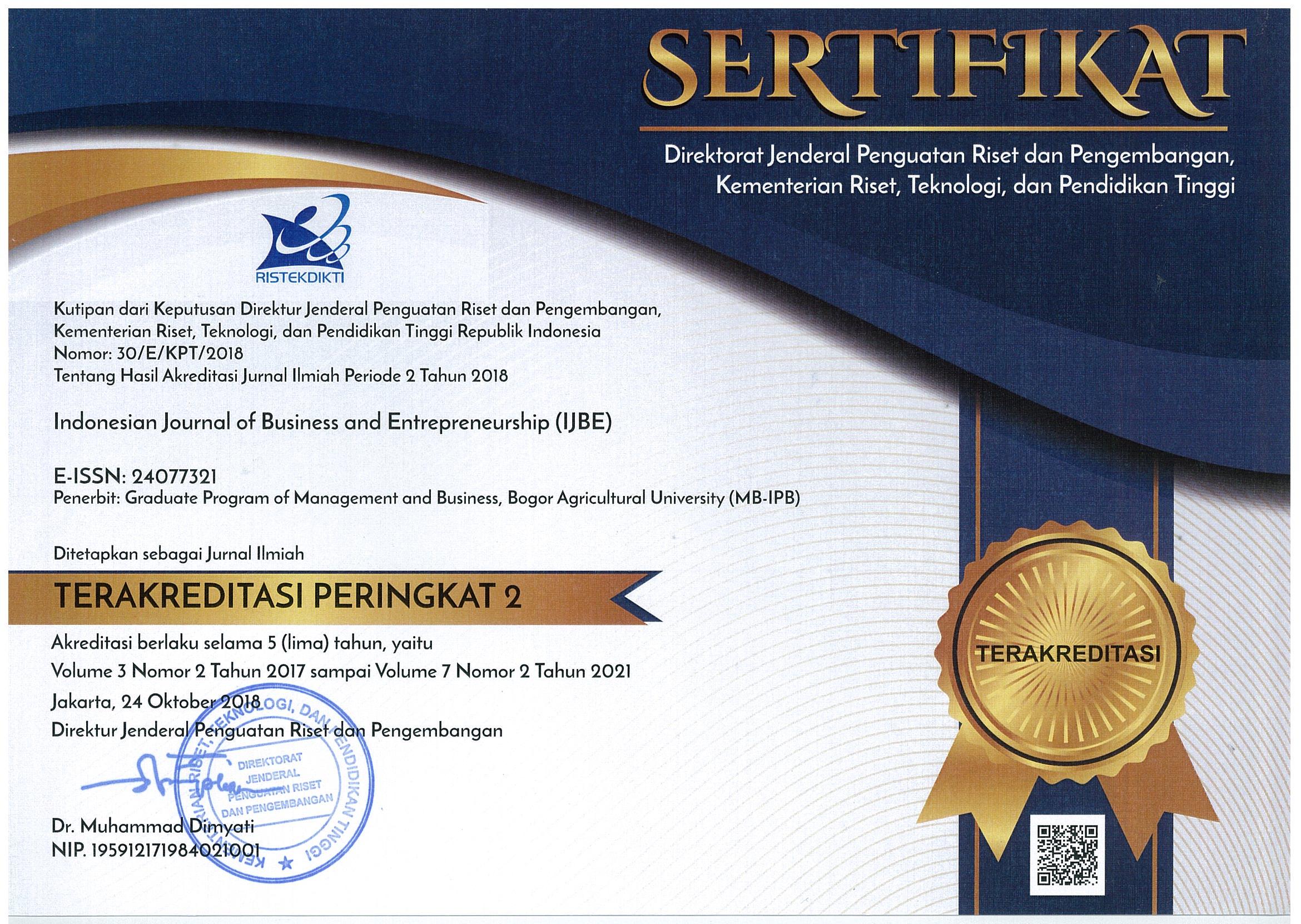ANALYSIS OF COFFEE FARMERS’ DECISION TO TAKE CREDIT IN PATI REGENCY
Abstract
Coffee Commodities in Pati were undeveloped compared to some other areas in Central Java as a coffee production center. Coffee farmers have some problems in the production of coffee: scarcity of subsidized fertilizers, difficulty to take credit, lack of dried coffee beans, and damaged roads that lead to expensive production costs. Coffee farmers play a role in the production activities as decision makers that will directly affect income. The aim of this research was to identify factors that influence the decision of coffee farmers to take credit. The study was conducted in coffee plantations of Klakahkasihan Village, Gembong, Pati. Cross-section data from Sido Makmur farmer group in Klakahkasihan village were collected directly from 52 respondents. They were 32 farmers who took and 20 farmers who did not take credit. The method used to analyze was probit method analysis. The results showed that the land area and the age of coffee plant variables had a negative coefficients, which means the smaller the land area and the younger the coffee plants, the higher the chances to take the credit. While the number of family members had a positive coefficient, which means that the greater the number of family members, the more chances farmers will take credit. Based on the above results it can be concluded that the farmer's decision to take credit is not for production process, but for other purposes.Keywords:farmer decisions, access credit, coffee plantation,Sido Makmur farmer groups, Pati
Downloads
References
Anyiro CO,Oriaku BN. 2011. Access to and Investment of Formal Micro Credit by Small Holder Farmers in Abia State, Nigeria. A Case Study of Absu Microfinance Bank, Uturu. The Journal of Agribusiness Sciences 6(2): 69-76.
Briquette C. 1999. Better practices in Agricultural lending. FAO publication.
Diagne A. 1999. Determinants of Household Access to and participantion in Formal and Informal Credit Markets in Malawi. Food Consumption and Nutrition Division (FCND) Discussion Paper 67, IFPRL, Wahington.
Diagne A, Manfred Z. 2001. Access to Credit and Its Impact on Welfare in Malawi. Research Report No. 116. Washington DC: International Food Policy Research Institute.
Ertherington M. 1984. Strategi Rehabilitasi Perkebunan Teh di Indonesia, hal. 109.
Hoff K, Stinglizt JE. 1993. Imperfect Information and Rural Credit Market: Puzzles and Policy Perspectives. In The Economics of Rural Organization: Theory, Practice and Policy. Edited by Hoff, K, et al. Oxford University Press, New York.
Jaya, SA. 2012. Analisis Pendapatan Petani Pekebun Kopi Studi Kausu Perkebunan Kopi Rakyat Kecamatan Gembong, Kabupaten Pati, Jawa Tengah, 2010 [Skripsi]. Yogyakarta: Universitas Atma Jaya Yogyakarta.
Komicha, Hussein H. 2007. Farm Household Economic Behavior in Imperfect Financial market. Empirical Evidence and Policy Implications on Saving, Credit and Production Efficiency in Southeastern Ethiopia. [Doctoral Thesis], Swedish university of Agricultural Science Uppsala.
Mohamed K. 2003. Access to Formal and Quasi – Formal Credit by Smallholder Farmers and Artisonal Fishermen: A Case of Zanzibar. Research on Proverty Alleviation (REPOA). http://www.mkukinanyota.com. [20 Oktober 2015].
Mosher AT. 1978. Menggerakkan dan Membangun Pertanian, Syarat – syrat Pokok Perkembangan dan Modernisasi. Jakarta: CV Yasaguna.
Muayila KH, Tollens E. 2012. Assessing the Impact of Credit Constraints on Farm Household Economic Welfare in the Hinterland of Kinshasa, Democratic Republic of Congo. AJFAND ONLINE 12.
Mubyarto. 1985. Pengantar Ekonomi Pertanian. Jakarta: LP3ES.
Nuryantono N. 2007. Credit Rationing Of Farm Households and Agricultural Production: Empirical Evidence In The Rural Area of Central Sulawesi, Indonesia. Jurnal Manajemen dan Agribisnis 4(1): 15–21.
Ogada M, W Nyangena, and M. Yusuf. 2010. Production Risk and Farm Technology Adoption in The Rain – Fed, Semi – Arid Lands of Kenya. AfJARE 4 (1):154–174.
Patikab. 2014. Selayang Pandang Kopi.http://dishutbun.patikab.go.id/?p=25. [17 Oktober 2015].
de Rosari BB et al. The Impact of Credit and Capital Supports on Economic Behavior of Farm Households: A Household Economic Appoarch. International Journal of Food and Agricultural Economics 2(3).
Sai Tang et al. 2010. Formal and Informal Credit Markets and Rural Credit Demand in China. Seleted Paper prepared for presentation at the Agricultural & Apllied Economics Association 2010 AAEA CAES & WAEA Joint Annual Meeting, Denver, Colorado, July 25 – 27, 2010. http://ageconsearch.umn.edu. [20 Juli 2015].
Simtowe, Franklin, Mantreed Z. 2006. The Impact to Access to Credit on the Adoption of Hybrid Maize in Malawi. An Empirical test of an Agricultural Household Model under credits market Failure. Munich PersonalRePEc Archive.http://mpra.ub.uni-muenchen.de/45/. [31 Agustus 2015].
Singh I, L. Squire, J. Strause. 1986. Agricultural Houseld Model: Extension, Aplication, and Policy. Baltimore:The John Hopkins University Press.
Wati DR. 2015. Akses dan dampak kredit mikro terhadap produksi dan pendapatan usahatani padi organik di Kabupaten Bogor. [Tesis]. Bogor: Sekolah Program Pascasarjana, Institut Pertanian Bogor.
Yehuala, S. 2008. Determinants of Smallholder Farmers Access to Formal Credit: The Case of Memeta Woreda, North Gondar, Ethiopia. [Thesis]. The Agriculturae Departement of Rural Development and Agricultural Extension School Haramaya University. https://cgspace.cgiar.org/bitstream/handle/10568/691/Thesis_YehualaDeterminants.pdf?sequence=1.[26 Oktober 2015].








